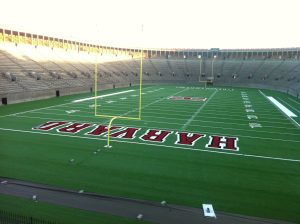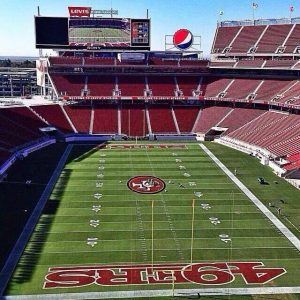How Many Acres Is a Football Field
A football field, often referred to as a gridiron, serves as the iconic battleground for the exhilarating sport of American football. Spanning a vast expanse, the dimensions of a football field are meticulously standardized to provide a fair and competitive arena for teams to clash. The question of how many acres a football field covers is pivotal to understanding the sheer scale of this playing field, where athletes demonstrate their prowess and strategies unfold against the backdrop of painted yard lines and end zones.
The Dimensions of a Football Field
A football field’s dimensions are standardized across different levels of the game. These dimensions contribute to the game’s fairness and strategy. The field is divided into three main parts: two identical end zones and the playing field in between.
Length of the Field
The length of a standard football field, including both end zones, is 120 yards. This distance is equivalent to 360 feet or about 109.7 meters. The end zones themselves are each 10 yards long, adding up to the total field length.
Width of the Field
The width of the football field is 53.3 yards, which translates to approximately 160 feet or 48.8 meters. The field’s width contributes to the challenges and tactics used by players during the game.
Calculating the Area in Square Yards
To calculate the total area of the football field, we need to consider the entire rectangular playing area, including both end zones. The formula to find the area of a rectangle is length multiplied by width. For a standard football field:
Area = Length × Width Area = 120 yards × 53.3 yards
Converting Square Yards to Acres
Now that we have the area in square yards, let’s convert it to acres. One acre is equivalent to 4,840 square yards. By dividing the total area of the football field by the number of square yards in an acre, we can determine how many acres the field occupies. Also, read about How Long Is a Tennis Match
The Resulting Acreage
After performing the calculations, a standard football field covers approximately 1.32 acres. This may not seem like a large area, but when you consider the intensity and excitement that unfolds in this limited space, it becomes clear why it’s such an integral part of the game.
Why Acreage Matters
Understanding the acreage of a football field isn’t just a matter of trivia—it plays a crucial role in strategy and gameplay. The dimensions of the field influence team dynamics, player positioning, and the overall flow of the game.
Impact on Gameplay
The limited acreage encourages fast-paced action and dynamic plays, as players must strategically position themselves to advance the ball toward the end zones. The compact nature of the field leads to intense matchups and thrilling moments. Discover more India vs West Indies| The Exciting Cricket Rivalry
Strategic Considerations
Teams must adapt their strategies based on the field’s dimensions. Offenses need to capitalize on the limited space, while defenses work to prevent opponents from making significant gains. This strategic interplay keeps fans engaged from kickoff to the final whistle.

Acreage Beyond Football
While football fields have their unique acreage, the concept of acreage is more widespread and diverse than you might think.
Everyday Context
An acre is a unit of area commonly used in real estate, agriculture, and land management. It’s often associated with the size of plots, farms, and other open spaces. Understanding how acreage is used in different contexts can provide a broader perspective on measurements and space.
Putting It in Perspective: A Visual Comparison
To better understand the vastness of a football field, consider this: the field’s total area is larger than that of many residential lots and even some small farms. Its immense size provides ample space for players to showcase their skills and for fans to enjoy the game.
Why the Size Matters in Football
The size of a football field influences the pace of the game, player positions, and overall strategy. The dimensions impact how teams attack and defend, requiring players to adapt their techniques accordingly.
Historical Evolution of Football Field Dimensions
The dimensions of football fields have evolved over time. Early variations were less standardized, but as the game’s popularity grew, governing bodies established uniform measurements to ensure fairness.
Differences in Field Sizes: American Football vs. Soccer
While both American football and soccer are played on rectangular fields, their dimensions differ significantly. Soccer fields are generally larger, emphasizing endurance and continuous play, whereas American football fields are more compact to suit the game’s nature. Also, read about How Long Is a Tennis Match
Notable Stadiums with Unique Field Sizes
Some stadiums around the world have unique field dimensions due to space constraints or innovative design choices. These differences can impact gameplay and add to the distinct character of each venue.
Innovations in Field Design and Technology
Advancements in field design and technology have led to better playing surfaces and enhanced player safety. Artificial turf, for example, allows for consistent performance regardless of weather conditions.
Maintaining the Integrity of the Field
The upkeep of a football field is essential to ensure fair and safe play. Groundskeepers use specialized techniques and equipment to maintain the field’s quality throughout the season.
The Role of Field Size in Game Strategies
Field size directly affects team strategies. A larger field encourages wide plays and long passes, while a smaller field necessitates tighter formations and quicker decision-making.
Factors Influencing Field Size Regulations
Various factors, such as governing bodies’ regulations, available space, and regional preferences, influence the dimensions of football fields. Balancing tradition and practicality is key.

The Iconic Halfway Line and Its Significance
The halfway line divides the field into two equal halves and plays a symbolic role in the game. It’s where kickoffs and the initial ball placements occur.
Conclusion
In conclusion, the size of a football field is not just a set of measurements—it’s a crucial element that shapes the way the game is played. Understanding the dimensions and their implications adds a new layer of appreciation for the sport’s complexity and strategy.
FAQs
Is the size of a football field the same for all levels of play?
The dimensions of a football field are standardized across most levels of play, although some variations exist.
What is the purpose of the end zones on a football field?
End zones serve as the areas where players aim to score touchdowns and where kickoffs are received.
Are there any regulations about the field’s surface material?
Different leagues have specific regulations regarding field surfaces, with natural grass and artificial turf being the most common choices.
Why are soccer fields generally larger than football fields?
The larger size of soccer fields accommodates the continuous style of play in the sport, allowing players to cover more ground.
How do weather conditions affect the field’s condition?
Extreme weather conditions can impact the quality of the field’s surface, which is why many modern stadiums have retractable roofs or artificial turf.
